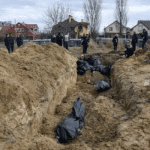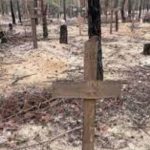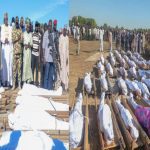The UN human rights chief, Volker Türk, has expressed his shock at hearing about mass graves at two of Gaza’s biggest hospitals that had hundreds of bodies, calling them “horrified.”
Following the withdrawal of Israeli troops last week, Palestinian civil defense teams started digging up bodies from a mass grave outside the Nasser hospital complex in Khan Younis.
According to Palestinian officials, 310 dead have been discovered in the previous week, 35 of which were discovered yesterday.

She described bodies “buried deep in the ground and covered with waste”, adding that “among the deceased were allegedly older people, women and wounded”, including some bound and stripped of their clothes.
“Some of them had their hands tied, which of course indicates serious violations of international human rights law and international humanitarian law, and these need to be subjected to further investigations,” she said.
Palestinian rescue teams and several observation missions from the UN also reported the discovery of multiple mass grave sites in the Shifa hospital compound, in Gaza City, earlier this month, after Israeli ground troops withdrew after a prolonged siege.
Medics working for Doctors Without Borders described how Israeli forces attacked Nasser hospital in late January before withdrawing a month later, leaving the facility unable to function.
Rescue workers are continuing to dig through the sandy earth to exhume bodies outside the hospital. Shamdasani said her office was working on corroborating Palestinian officials’ reports that hundreds of bodies had been found at the site.
Officials in Gaza said the bodies at Nasser were people who had died during the siege. Israel’s military on Tuesday rejected allegations of mass burials at the hospital, saying it had exhumed corpses to try to find hostages taken by Hamas in October.
Israel has repeatedly accused Hamas of operating in hospitals and using medical infrastructure as a shield, which Hamas denies.
The UN rights chief also condemned increasing numbers of Israeli airstrikes that have pummelled northern, central and southern Gaza in recent days, including naval artillery fire that has struck buildings along Gaza’s eastern shoreline.
Airstrikes hit many areas already reduced to little more than rubble and broken slabs of concrete after 200 days of war, including Beit Lahia in the north and the centre of Gaza City.
As Israeli ground troops reportedly staged a brief incursion into eastern Khan Younis, in the south of Gaza, satellite images from the destroyed city showed a growing tent encampment, which could be intended to house people fleeing Rafah in the event of an Israeli ground attack there.
Benjamin Netanyahu, the Israeli prime minister, has repeatedly threatened to attack Rafah, Gaza’s southernmost city, where more than a million people are sheltering. On Tuesday, Türk again warned against a full-scale incursion on Rafah, saying it could lead to “further atrocity crimes”.
Melanie Ward, the head of Medical Aid for Palestinians, who has recently returned from a visit to Gaza, said an Israeli invasion would be impossible without “human slaughter.”
Many of the recent strikes have hit parts of Gaza where people already displaced have fled for the third, fourth, or even fifth time.
The UN human rights chief, Volker Türk, has expressed his shock at hearing about mass graves at two of Gaza’s biggest hospitals that had hundreds of bodies, calling them “horrified.”
Following the withdrawal of Israeli troops last week, Palestinian civil defense teams started digging up bodies from a mass grave outside the Nasser hospital complex in Khan Younis.
According to Palestinian officials, 310 dead have been discovered in the previous week, 35 of which were discovered yesterday.

She described bodies “buried deep in the ground and covered with waste”, adding that “among the deceased were allegedly older people, women and wounded”, including some bound and stripped of their clothes.
“Some of them had their hands tied, which of course indicates serious violations of international human rights law and international humanitarian law, and these need to be subjected to further investigations,” she said.
Palestinian rescue teams and several observation missions from the UN also reported the discovery of multiple mass grave sites in the Shifa hospital compound, in Gaza City, earlier this month, after Israeli ground troops withdrew after a prolonged siege.
Medics working for Doctors Without Borders described how Israeli forces attacked Nasser hospital in late January before withdrawing a month later, leaving the facility unable to function.
Rescue workers are continuing to dig through the sandy earth to exhume bodies outside the hospital. Shamdasani said her office was working on corroborating Palestinian officials’ reports that hundreds of bodies had been found at the site.
Officials in Gaza said the bodies at Nasser were people who had died during the siege. Israel’s military on Tuesday rejected allegations of mass burials at the hospital, saying it had exhumed corpses to try to find hostages taken by Hamas in October.
Israel has repeatedly accused Hamas of operating in hospitals and using medical infrastructure as a shield, which Hamas denies.
The UN rights chief also condemned increasing numbers of Israeli airstrikes that have pummelled northern, central and southern Gaza in recent days, including naval artillery fire that has struck buildings along Gaza’s eastern shoreline.
Airstrikes hit many areas already reduced to little more than rubble and broken slabs of concrete after 200 days of war, including Beit Lahia in the north and the centre of Gaza City.
As Israeli ground troops reportedly staged a brief incursion into eastern Khan Younis, in the south of Gaza, satellite images from the destroyed city showed a growing tent encampment, which could be intended to house people fleeing Rafah in the event of an Israeli ground attack there.
Benjamin Netanyahu, the Israeli prime minister, has repeatedly threatened to attack Rafah, Gaza’s southernmost city, where more than a million people are sheltering. On Tuesday, Türk again warned against a full-scale incursion on Rafah, saying it could lead to “further atrocity crimes”.
Melanie Ward, the head of Medical Aid for Palestinians, who has recently returned from a visit to Gaza, said an Israeli invasion would be impossible without “human slaughter.”
Many of the recent strikes have hit parts of Gaza where people already displaced have fled for the third, fourth, or even fifth time.
The UN human rights chief, Volker Türk, has expressed his shock at hearing about mass graves at two of Gaza’s biggest hospitals that had hundreds of bodies, calling them “horrified.”
Following the withdrawal of Israeli troops last week, Palestinian civil defense teams started digging up bodies from a mass grave outside the Nasser hospital complex in Khan Younis.
According to Palestinian officials, 310 dead have been discovered in the previous week, 35 of which were discovered yesterday.

She described bodies “buried deep in the ground and covered with waste”, adding that “among the deceased were allegedly older people, women and wounded”, including some bound and stripped of their clothes.
“Some of them had their hands tied, which of course indicates serious violations of international human rights law and international humanitarian law, and these need to be subjected to further investigations,” she said.
Palestinian rescue teams and several observation missions from the UN also reported the discovery of multiple mass grave sites in the Shifa hospital compound, in Gaza City, earlier this month, after Israeli ground troops withdrew after a prolonged siege.
Medics working for Doctors Without Borders described how Israeli forces attacked Nasser hospital in late January before withdrawing a month later, leaving the facility unable to function.
Rescue workers are continuing to dig through the sandy earth to exhume bodies outside the hospital. Shamdasani said her office was working on corroborating Palestinian officials’ reports that hundreds of bodies had been found at the site.
Officials in Gaza said the bodies at Nasser were people who had died during the siege. Israel’s military on Tuesday rejected allegations of mass burials at the hospital, saying it had exhumed corpses to try to find hostages taken by Hamas in October.
Israel has repeatedly accused Hamas of operating in hospitals and using medical infrastructure as a shield, which Hamas denies.
The UN rights chief also condemned increasing numbers of Israeli airstrikes that have pummelled northern, central and southern Gaza in recent days, including naval artillery fire that has struck buildings along Gaza’s eastern shoreline.
Airstrikes hit many areas already reduced to little more than rubble and broken slabs of concrete after 200 days of war, including Beit Lahia in the north and the centre of Gaza City.
As Israeli ground troops reportedly staged a brief incursion into eastern Khan Younis, in the south of Gaza, satellite images from the destroyed city showed a growing tent encampment, which could be intended to house people fleeing Rafah in the event of an Israeli ground attack there.
Benjamin Netanyahu, the Israeli prime minister, has repeatedly threatened to attack Rafah, Gaza’s southernmost city, where more than a million people are sheltering. On Tuesday, Türk again warned against a full-scale incursion on Rafah, saying it could lead to “further atrocity crimes”.
Melanie Ward, the head of Medical Aid for Palestinians, who has recently returned from a visit to Gaza, said an Israeli invasion would be impossible without “human slaughter.”
Many of the recent strikes have hit parts of Gaza where people already displaced have fled for the third, fourth, or even fifth time.
The UN human rights chief, Volker Türk, has expressed his shock at hearing about mass graves at two of Gaza’s biggest hospitals that had hundreds of bodies, calling them “horrified.”
Following the withdrawal of Israeli troops last week, Palestinian civil defense teams started digging up bodies from a mass grave outside the Nasser hospital complex in Khan Younis.
According to Palestinian officials, 310 dead have been discovered in the previous week, 35 of which were discovered yesterday.

She described bodies “buried deep in the ground and covered with waste”, adding that “among the deceased were allegedly older people, women and wounded”, including some bound and stripped of their clothes.
“Some of them had their hands tied, which of course indicates serious violations of international human rights law and international humanitarian law, and these need to be subjected to further investigations,” she said.
Palestinian rescue teams and several observation missions from the UN also reported the discovery of multiple mass grave sites in the Shifa hospital compound, in Gaza City, earlier this month, after Israeli ground troops withdrew after a prolonged siege.
Medics working for Doctors Without Borders described how Israeli forces attacked Nasser hospital in late January before withdrawing a month later, leaving the facility unable to function.
Rescue workers are continuing to dig through the sandy earth to exhume bodies outside the hospital. Shamdasani said her office was working on corroborating Palestinian officials’ reports that hundreds of bodies had been found at the site.
Officials in Gaza said the bodies at Nasser were people who had died during the siege. Israel’s military on Tuesday rejected allegations of mass burials at the hospital, saying it had exhumed corpses to try to find hostages taken by Hamas in October.
Israel has repeatedly accused Hamas of operating in hospitals and using medical infrastructure as a shield, which Hamas denies.
The UN rights chief also condemned increasing numbers of Israeli airstrikes that have pummelled northern, central and southern Gaza in recent days, including naval artillery fire that has struck buildings along Gaza’s eastern shoreline.
Airstrikes hit many areas already reduced to little more than rubble and broken slabs of concrete after 200 days of war, including Beit Lahia in the north and the centre of Gaza City.
As Israeli ground troops reportedly staged a brief incursion into eastern Khan Younis, in the south of Gaza, satellite images from the destroyed city showed a growing tent encampment, which could be intended to house people fleeing Rafah in the event of an Israeli ground attack there.
Benjamin Netanyahu, the Israeli prime minister, has repeatedly threatened to attack Rafah, Gaza’s southernmost city, where more than a million people are sheltering. On Tuesday, Türk again warned against a full-scale incursion on Rafah, saying it could lead to “further atrocity crimes”.
Melanie Ward, the head of Medical Aid for Palestinians, who has recently returned from a visit to Gaza, said an Israeli invasion would be impossible without “human slaughter.”
Many of the recent strikes have hit parts of Gaza where people already displaced have fled for the third, fourth, or even fifth time.
The UN human rights chief, Volker Türk, has expressed his shock at hearing about mass graves at two of Gaza’s biggest hospitals that had hundreds of bodies, calling them “horrified.”
Following the withdrawal of Israeli troops last week, Palestinian civil defense teams started digging up bodies from a mass grave outside the Nasser hospital complex in Khan Younis.
According to Palestinian officials, 310 dead have been discovered in the previous week, 35 of which were discovered yesterday.

She described bodies “buried deep in the ground and covered with waste”, adding that “among the deceased were allegedly older people, women and wounded”, including some bound and stripped of their clothes.
“Some of them had their hands tied, which of course indicates serious violations of international human rights law and international humanitarian law, and these need to be subjected to further investigations,” she said.
Palestinian rescue teams and several observation missions from the UN also reported the discovery of multiple mass grave sites in the Shifa hospital compound, in Gaza City, earlier this month, after Israeli ground troops withdrew after a prolonged siege.
Medics working for Doctors Without Borders described how Israeli forces attacked Nasser hospital in late January before withdrawing a month later, leaving the facility unable to function.
Rescue workers are continuing to dig through the sandy earth to exhume bodies outside the hospital. Shamdasani said her office was working on corroborating Palestinian officials’ reports that hundreds of bodies had been found at the site.
Officials in Gaza said the bodies at Nasser were people who had died during the siege. Israel’s military on Tuesday rejected allegations of mass burials at the hospital, saying it had exhumed corpses to try to find hostages taken by Hamas in October.
Israel has repeatedly accused Hamas of operating in hospitals and using medical infrastructure as a shield, which Hamas denies.
The UN rights chief also condemned increasing numbers of Israeli airstrikes that have pummelled northern, central and southern Gaza in recent days, including naval artillery fire that has struck buildings along Gaza’s eastern shoreline.
Airstrikes hit many areas already reduced to little more than rubble and broken slabs of concrete after 200 days of war, including Beit Lahia in the north and the centre of Gaza City.
As Israeli ground troops reportedly staged a brief incursion into eastern Khan Younis, in the south of Gaza, satellite images from the destroyed city showed a growing tent encampment, which could be intended to house people fleeing Rafah in the event of an Israeli ground attack there.
Benjamin Netanyahu, the Israeli prime minister, has repeatedly threatened to attack Rafah, Gaza’s southernmost city, where more than a million people are sheltering. On Tuesday, Türk again warned against a full-scale incursion on Rafah, saying it could lead to “further atrocity crimes”.
Melanie Ward, the head of Medical Aid for Palestinians, who has recently returned from a visit to Gaza, said an Israeli invasion would be impossible without “human slaughter.”
Many of the recent strikes have hit parts of Gaza where people already displaced have fled for the third, fourth, or even fifth time.
The UN human rights chief, Volker Türk, has expressed his shock at hearing about mass graves at two of Gaza’s biggest hospitals that had hundreds of bodies, calling them “horrified.”
Following the withdrawal of Israeli troops last week, Palestinian civil defense teams started digging up bodies from a mass grave outside the Nasser hospital complex in Khan Younis.
According to Palestinian officials, 310 dead have been discovered in the previous week, 35 of which were discovered yesterday.

She described bodies “buried deep in the ground and covered with waste”, adding that “among the deceased were allegedly older people, women and wounded”, including some bound and stripped of their clothes.
“Some of them had their hands tied, which of course indicates serious violations of international human rights law and international humanitarian law, and these need to be subjected to further investigations,” she said.
Palestinian rescue teams and several observation missions from the UN also reported the discovery of multiple mass grave sites in the Shifa hospital compound, in Gaza City, earlier this month, after Israeli ground troops withdrew after a prolonged siege.
Medics working for Doctors Without Borders described how Israeli forces attacked Nasser hospital in late January before withdrawing a month later, leaving the facility unable to function.
Rescue workers are continuing to dig through the sandy earth to exhume bodies outside the hospital. Shamdasani said her office was working on corroborating Palestinian officials’ reports that hundreds of bodies had been found at the site.
Officials in Gaza said the bodies at Nasser were people who had died during the siege. Israel’s military on Tuesday rejected allegations of mass burials at the hospital, saying it had exhumed corpses to try to find hostages taken by Hamas in October.
Israel has repeatedly accused Hamas of operating in hospitals and using medical infrastructure as a shield, which Hamas denies.
The UN rights chief also condemned increasing numbers of Israeli airstrikes that have pummelled northern, central and southern Gaza in recent days, including naval artillery fire that has struck buildings along Gaza’s eastern shoreline.
Airstrikes hit many areas already reduced to little more than rubble and broken slabs of concrete after 200 days of war, including Beit Lahia in the north and the centre of Gaza City.
As Israeli ground troops reportedly staged a brief incursion into eastern Khan Younis, in the south of Gaza, satellite images from the destroyed city showed a growing tent encampment, which could be intended to house people fleeing Rafah in the event of an Israeli ground attack there.
Benjamin Netanyahu, the Israeli prime minister, has repeatedly threatened to attack Rafah, Gaza’s southernmost city, where more than a million people are sheltering. On Tuesday, Türk again warned against a full-scale incursion on Rafah, saying it could lead to “further atrocity crimes”.
Melanie Ward, the head of Medical Aid for Palestinians, who has recently returned from a visit to Gaza, said an Israeli invasion would be impossible without “human slaughter.”
Many of the recent strikes have hit parts of Gaza where people already displaced have fled for the third, fourth, or even fifth time.
The UN human rights chief, Volker Türk, has expressed his shock at hearing about mass graves at two of Gaza’s biggest hospitals that had hundreds of bodies, calling them “horrified.”
Following the withdrawal of Israeli troops last week, Palestinian civil defense teams started digging up bodies from a mass grave outside the Nasser hospital complex in Khan Younis.
According to Palestinian officials, 310 dead have been discovered in the previous week, 35 of which were discovered yesterday.

She described bodies “buried deep in the ground and covered with waste”, adding that “among the deceased were allegedly older people, women and wounded”, including some bound and stripped of their clothes.
“Some of them had their hands tied, which of course indicates serious violations of international human rights law and international humanitarian law, and these need to be subjected to further investigations,” she said.
Palestinian rescue teams and several observation missions from the UN also reported the discovery of multiple mass grave sites in the Shifa hospital compound, in Gaza City, earlier this month, after Israeli ground troops withdrew after a prolonged siege.
Medics working for Doctors Without Borders described how Israeli forces attacked Nasser hospital in late January before withdrawing a month later, leaving the facility unable to function.
Rescue workers are continuing to dig through the sandy earth to exhume bodies outside the hospital. Shamdasani said her office was working on corroborating Palestinian officials’ reports that hundreds of bodies had been found at the site.
Officials in Gaza said the bodies at Nasser were people who had died during the siege. Israel’s military on Tuesday rejected allegations of mass burials at the hospital, saying it had exhumed corpses to try to find hostages taken by Hamas in October.
Israel has repeatedly accused Hamas of operating in hospitals and using medical infrastructure as a shield, which Hamas denies.
The UN rights chief also condemned increasing numbers of Israeli airstrikes that have pummelled northern, central and southern Gaza in recent days, including naval artillery fire that has struck buildings along Gaza’s eastern shoreline.
Airstrikes hit many areas already reduced to little more than rubble and broken slabs of concrete after 200 days of war, including Beit Lahia in the north and the centre of Gaza City.
As Israeli ground troops reportedly staged a brief incursion into eastern Khan Younis, in the south of Gaza, satellite images from the destroyed city showed a growing tent encampment, which could be intended to house people fleeing Rafah in the event of an Israeli ground attack there.
Benjamin Netanyahu, the Israeli prime minister, has repeatedly threatened to attack Rafah, Gaza’s southernmost city, where more than a million people are sheltering. On Tuesday, Türk again warned against a full-scale incursion on Rafah, saying it could lead to “further atrocity crimes”.
Melanie Ward, the head of Medical Aid for Palestinians, who has recently returned from a visit to Gaza, said an Israeli invasion would be impossible without “human slaughter.”
Many of the recent strikes have hit parts of Gaza where people already displaced have fled for the third, fourth, or even fifth time.
The UN human rights chief, Volker Türk, has expressed his shock at hearing about mass graves at two of Gaza’s biggest hospitals that had hundreds of bodies, calling them “horrified.”
Following the withdrawal of Israeli troops last week, Palestinian civil defense teams started digging up bodies from a mass grave outside the Nasser hospital complex in Khan Younis.
According to Palestinian officials, 310 dead have been discovered in the previous week, 35 of which were discovered yesterday.

She described bodies “buried deep in the ground and covered with waste”, adding that “among the deceased were allegedly older people, women and wounded”, including some bound and stripped of their clothes.
“Some of them had their hands tied, which of course indicates serious violations of international human rights law and international humanitarian law, and these need to be subjected to further investigations,” she said.
Palestinian rescue teams and several observation missions from the UN also reported the discovery of multiple mass grave sites in the Shifa hospital compound, in Gaza City, earlier this month, after Israeli ground troops withdrew after a prolonged siege.
Medics working for Doctors Without Borders described how Israeli forces attacked Nasser hospital in late January before withdrawing a month later, leaving the facility unable to function.
Rescue workers are continuing to dig through the sandy earth to exhume bodies outside the hospital. Shamdasani said her office was working on corroborating Palestinian officials’ reports that hundreds of bodies had been found at the site.
Officials in Gaza said the bodies at Nasser were people who had died during the siege. Israel’s military on Tuesday rejected allegations of mass burials at the hospital, saying it had exhumed corpses to try to find hostages taken by Hamas in October.
Israel has repeatedly accused Hamas of operating in hospitals and using medical infrastructure as a shield, which Hamas denies.
The UN rights chief also condemned increasing numbers of Israeli airstrikes that have pummelled northern, central and southern Gaza in recent days, including naval artillery fire that has struck buildings along Gaza’s eastern shoreline.
Airstrikes hit many areas already reduced to little more than rubble and broken slabs of concrete after 200 days of war, including Beit Lahia in the north and the centre of Gaza City.
As Israeli ground troops reportedly staged a brief incursion into eastern Khan Younis, in the south of Gaza, satellite images from the destroyed city showed a growing tent encampment, which could be intended to house people fleeing Rafah in the event of an Israeli ground attack there.
Benjamin Netanyahu, the Israeli prime minister, has repeatedly threatened to attack Rafah, Gaza’s southernmost city, where more than a million people are sheltering. On Tuesday, Türk again warned against a full-scale incursion on Rafah, saying it could lead to “further atrocity crimes”.
Melanie Ward, the head of Medical Aid for Palestinians, who has recently returned from a visit to Gaza, said an Israeli invasion would be impossible without “human slaughter.”
Many of the recent strikes have hit parts of Gaza where people already displaced have fled for the third, fourth, or even fifth time.














